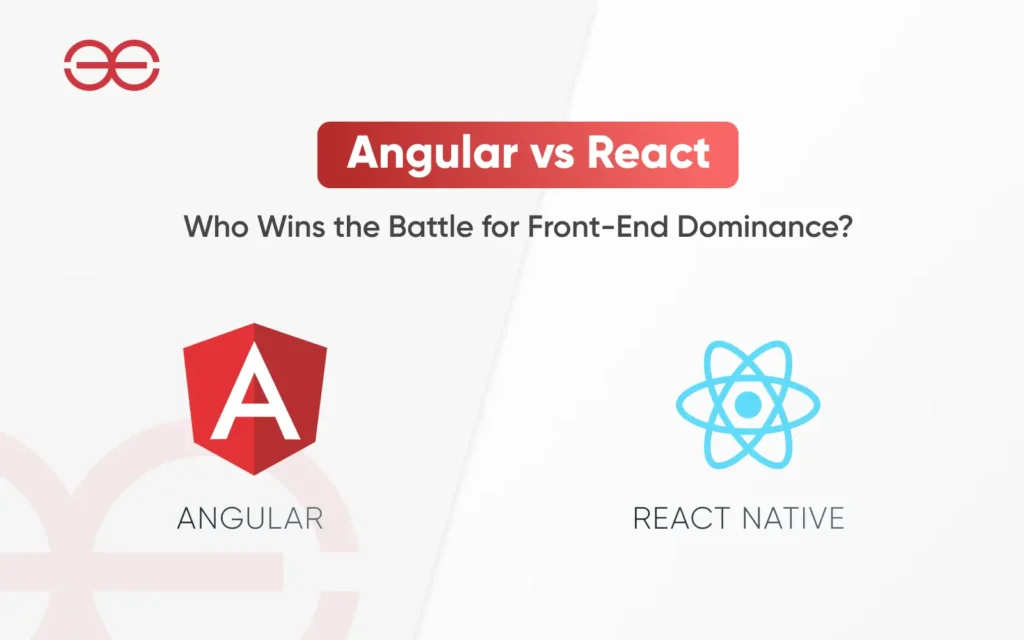
Angular vs React: Who Wins the Battle for Front-End Dominance?
Angular vs React… these two titans have been locked in a battle for front-end supremacy for years now. These two JavaScript frameworks have their passionate defenders and detractors, ready to defend their preferred framework and poke holes in the other – lighting up online forums with impassioned debates. Yet behind this front-end frame work war lies a deeper question—which tool works best for front end development?
Both Angular and React enable web development teams to build complex, high-performance applications. But they go about it in fundamentally different ways. Angular offers structure and consistency, while React provides flexibility and control.
Hold on, you seem a bit puzzled!
Don’t worry we’ve put together a comprehensive guide to help you understand these two tech stacks in detail. In this blog post, we’ll dig into the origins, technical capabilities, and ideal use cases of both Angular and React.
By the end, you’ll understand what differentiates these tools and where each excels based on the needs of your mobile app development. Alright developers, set aside your differences and find some common ground!
Here’s what you need to know…but before comparing Angular vs React, let’s independently examine each framework.
What is Angular?
Angular is an open-source web application framework originally created and maintained by Google. First released in 2010, it builds on established software engineering patterns to provide an efficient way to create single-page applications using HTML and TypeScript.
As an MVC (model-view-controller) framework, Angular incorporates the following key capabilities:
- Declarative Templates: HTML templates are used to define views using a clear, declarative coding style.
- Powerful Data Binding: Automatically sync data between models and views bi-directionally.
- MVC Architecture: Separates application logic according to the model, view, and controller layout.
- Client-side Capabilities: As a client-side framework, major processing happens on the browser rather than the server allowing faster UI refreshing.
- Reusability: Angular Components and Services encourage the reuse of common code.
- Extensibility: Features like directives allow extending HTML syntax to fit application needs.
- Testing: Framework integrates unit testing capabilities.
- Cross-platform: Build for web, mobile web, native mobile, and desktop apps with one skill.
The consistent structure and comprehensive capabilities Angular provides, enable the rapid development of complex, interactive web applications. The vibrant community ensures convenient access to a multitude of resources and ongoing support.
What is React?
React is an open-source JavaScript library for building user interfaces created and maintained by Facebook. First released in 2013, React aimed to address common pain points in web development like slow rendering and difficult maintenance of complex UIs.
As a component-based library, React offers these core capabilities:
- Composable Components: The component structure allows for complete UI breakdown into reusable, isolated pieces of code called components.
- Virtual DOM: A virtual representation of the UI is kept in sync with the real DOM effectively minimizing expensive direct DOM manipulation.
- Unidirectional Data Flow: Data in React apps strictly follows a top-down, parent-to-child component data flow for predictability.
- High Performance: Utilizing a virtual DOM combined with sophisticated reconciliation algorithms results in exceptional rendering speed.
- Flexible: React integrates well into modern frameworks and can be used for small parts of an app up to large-scale system architecture.
- Testable: The component model and JavaScript code base is extremely test-friendly.
- Community Support: As one of the most popular libraries, React benefits from outstanding community contributions.
React’s streamlined yet powerful approach to views and component composition offers unparalleled flexibility. This enables developers to create user interfaces and intricate applications with high performance.
Isn’t the Angular vs React comparison fascinating?
Angular vs React: The Frontend Face-off
| Feature | Angular | React |
| Architecture | MVC (Model-View-Controller) | Component-Based |
| Rendering | Real DOM | Virtual DOM |
| Data Binding | Two-way Binding | One-way Binding |
| Learning Curve | Steep learning curve | Shorter learning curve |
| Testing | AngularJS has built-in dependency injection, making testing easier | Requires loading additional libraries like React TestUtils for testing |
| Community | Smaller than React | Very large community support |
| Company Origin | ||
| Mobile Development | Ionic and NativeScript frameworks | React Native |
| Bundle Size | Larger app bundle size | Smaller app bundle size |
| Documentation | The official documentation is very extensive | Official documentation is comparatively limited |
Performance Showdown: Which Framework Wins the Race?
Angular and React are two of the most popular front-end frameworks, each with its own strengths and weaknesses. In this showdown, we’ll compare Angular and React’s performance to see which one comes out on top – and which is the web development team’s first choice.
- Performance Comparison
Both Angular and React are capable of building highly performant applications. However, React tends to be faster overall according to most benchmarks. Here are some key performance factors to consider:
- Rendering Speed
React uses a virtual DOM diffing algorithm to minimize expensive DOM operations and re-render only components that actually changed. Angular has to update the entire real DOM whenever the component state changes. This gives React an advantage in the number of frames per second rendered.
- Startup Time
Angular needs to resolve all directives and dependencies at load, which can delay initial rendering. React only needs to initialize the components required for the initial routes/views so tends to start up faster.
- Change Detection
Angular uses zone.js change detection which provides automatic updates whenever component data changes. This constant tracking has a performance cost. React updates are handled manually through setState() calls so change detection is optimized.
- Mobile Performance
For mobile sites and apps, React Native provides faster UIs and smaller bundle sizes making it more performant than solutions like Ionic or NativeScript for Angular.
- Complex Applications
Angular can struggle to manage complex apps with a huge number of watchers leading to slow performance. React handles complex UIs more efficiently regardless of app size.
Angular vs React – while simple Angular apps can be very fast in the beginning, React scales better for larger enterprise-level applications with many components and frequent state changes. Let me know if you would like me to expand this comparison further!
Use Cases and Industry Adoption
Though both frameworks can build similarly powerful applications, each excels in certain use cases based on their technical capabilities and design philosophy.
-
Angular Use Cases
- Enterprise Applications – Angular’s comprehensive structure, standards, and extensive documentation lend well to large enterprise teams building complex business apps. The feature-richness helps accelerate development.
- CRUD Apps – Angular’s two-way data binding and MVC architecture make it ideal for apps focused on creating, reading, updating, and deleting data. The UI stays synced with data models automatically.
- Marketing Websites – For marketing sites that don’t require complex state management, Angular can enable rapid development of interactive and animated web pages.
- Mobile Apps – While React Native dominates for mobile, Angular can be used to build cross-platform native and web apps using Ionic and NativeScript.
Example Apps: Upwork, Forbes, BMW, NBC
-
React Use Cases
- Real-Time Apps – React’s virtual DOM and efficient state management are ideal for apps needing frequent updates like chat, streaming, and real-time analytics dashboards.
- Complex UIs – For advanced UI needs like animated timelines, dynamic charts, and 3D interfaces, React provides flexibility and performance.
- High-Traffic Sites – React handles complex sites with many components and heavy traffic extremely well. Major sites like Facebook and Instagram rely on it.
- Mobile Apps – React Native’s smooth native app UIs and smaller file size make it a top choice for building mobile apps cross-platform.
Example Apps: Facebook, Twitter, Netflix, Airbnb, Uber
Angular vs React: Advantages and Disadvantages
| Framework | Advantages | Disadvantages |
| React |
|
|
| Angular |
|
|
When to Choose Angular vs React frameworks?
With an understanding of the strengths and weaknesses of each framework, when should you choose Angular or React for your next project?
Choose Angular If:
- You need a feature-rich, batteries-included framework – Angular provides extensive capabilities out-of-the-box.
- Your app is focused on CRUD operations – Angular’s two-way data binding suits frequent data updates.
- You want strong project structure conventions – Angular’s MVC patterns provide cohesion for large teams.
- Your team prefers Typescript over JavaScript – Angular is built with Typescript.
- Time-to-market is critical – Angular can accelerate initial development.
Choose React If:
- You need a flexible, modular UI architecture – React’s composable components shine here.
- Your app needs high performance at scale – React handles complex UIs with ease.
- Real-time user experiences are critical – React excels at rapidly updating UIs.
- Your team prefers Javascript – React uses JSX syntax.
- Advanced UI interactions are required – React’s power and flexibility enable custom UIs.
And the Winner is…
When it comes to Angular vs React, there may not be one clear winner. Both offer powerful capabilities in their own right. Angular provides structure and consistency for rapidly building enterprise apps. React offers flexibility and control for intricate UIs with dynamic data.
Consider your specific needs – if you prioritize rapid development and cohesive team collaboration, Angular and its robust ecosystem have your back. If you want to optimize complex interfaces and scale efficiently, React’s performance approach is hard to beat.
The good news is you don’t have to limit yourself to just one. Many modern web stacks integrate both frameworks in a complementary fashion. Mix and match to get the benefits of both worlds. And rest assured, regardless of which horse you back, you’ll be building on a stable, battle-tested foundation with Angular or React.
Little Hint: If you’re looking for React or Angular web/mobile app development, Geeks of Kolachi is your go-to expert.
Frequently Asked Questions
Q: Which framework has better documentation (Angular vs React)?
A: Angular tends to have more extensive official documentation and learning resources than React. This can make it easier for beginners to get started with Angular.
Q: Can Angular and React be used together?
A: Yes, Angular and React can complement each other well. For example, React can be used for reusable UI components in an Angular-based app.
Q: Is React faster than Angular?
A: In most benchmarks, React performs better than Angular. React’s virtual DOM and optimized rendering provide faster rendering speeds.
Q: Does Angular use real or virtual DOM?
A: Angular uses the real DOM and updates it directly when the component state changes. React maintains a virtual DOM for more efficient diffing.



















